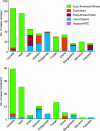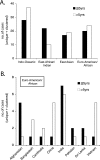Major Mycobacterium tuberculosis lineages associate with patient country of origin
- PMID: 19213699
- PMCID: PMC2668307
- DOI: 10.1128/JCM.02142-08
Major Mycobacterium tuberculosis lineages associate with patient country of origin
Abstract
Over recent years, there has been an increasing acknowledgment of the diversity that exists among Mycobacterium tuberculosis clinical isolates. To facilitate comparative studies aimed at deciphering the relevance of this diversity to human disease, an unambiguous and easily interpretable method of strain classification is required. Presently, the most effective means of assigning isolates into a series of unambiguous lineages is the method of Gagneux et al. (S. Gagneux et al., Proc. Natl. Acad. Sci. USA 103:2869-2873, 2006) that involves the PCR-based detection of large sequence polymorphisms (LSPs). In this manner, isolates are classified into six major lineages, the majority of which display a high degree of geographic restriction. Here we describe an independent replicate of the Gagneux study carried out on 798 isolates collected over a 6-year period from mostly foreign-born patients resident on the island of Montreal, Canada. The original trends in terms of bacterial genotype and patient ethnicity are remarkably conserved within this Montreal cohort, even though the patient distributions between the two populations are quite distinct. In parallel with the LSP analysis, we also demonstrate that "clustered" tuberculosis (TB) cases defined through restriction fragment length polymorphism (RFLP) analysis (for isolates with >or=6 IS6110 copies) or RFLP in combination with spoligotyping (for isolates with <6 IS6110 copies) do not stray across the LSP-defined lineage boundaries. However, our data also demonstrate the poor discriminatory power of either RFLP or spoligotyping alone for these low-IS6110-copy-number isolates. We believe that this independent validation of the LSP method should encourage researchers to adopt this system in investigations aimed at elucidating the role of strain variation in TB.
Figures




Similar articles
-
[The identification of Mycobacterium tuberculosis isolates by DNA typing technique].Zhonghua Liu Xing Bing Xue Za Zhi. 2005 May;26(5):361-5. Zhonghua Liu Xing Bing Xue Za Zhi. 2005. PMID: 16053765 Chinese.
-
Combined use of Amplified Fragment Length Polymorphism and IS6110-RFLP in fingerprinting clinical isolates of Mycobacterium tuberculosis from Kerala, South India.BMC Infect Dis. 2007 Jul 28;7:86. doi: 10.1186/1471-2334-7-86. BMC Infect Dis. 2007. PMID: 17662148 Free PMC article.
-
Spoligotyping and polymorphic GC-rich repetitive sequence fingerprinting of mycobacterium tuberculosis strains having few copies of IS6110.J Clin Microbiol. 2000 Oct;38(10):3572-6. doi: 10.1128/JCM.38.10.3572-3576.2000. J Clin Microbiol. 2000. PMID: 11015365 Free PMC article.
-
Comparison of restriction fragment length polymorphism with the polymorphic guanine-cytosine-rich sequence and spoligotyping for differentiation of Mycobacterium tuberculosis isolates with five or fewer copies of IS6110.J Clin Microbiol. 2010 Feb;48(2):575-8. doi: 10.1128/JCM.01604-09. Epub 2009 Dec 23. J Clin Microbiol. 2010. PMID: 20032250 Free PMC article.
-
Predominance of Mycobacterium tuberculosis EAI and Beijing lineages in Yangon, Myanmar.J Clin Microbiol. 2009 Feb;47(2):335-44. doi: 10.1128/JCM.01812-08. Epub 2008 Nov 26. J Clin Microbiol. 2009. PMID: 19036933 Free PMC article.
Cited by
-
Molecular epidemiology of clinical Mycobacterium tuberculosis complex isolates in South Omo, Southern Ethiopia.BMC Infect Dis. 2020 Oct 13;20(1):750. doi: 10.1186/s12879-020-05394-9. BMC Infect Dis. 2020. PMID: 33050903 Free PMC article.
-
Mycobacterium tuberculosis spoligotypes in Monterrey, Mexico.J Clin Microbiol. 2010 Feb;48(2):448-55. doi: 10.1128/JCM.01894-09. Epub 2009 Nov 25. J Clin Microbiol. 2010. PMID: 19940048 Free PMC article.
-
Changing patterns of human migrations shaped the global population structure of Mycobacterium tuberculosis in France.Sci Rep. 2018 Apr 11;8(1):5855. doi: 10.1038/s41598-018-24034-6. Sci Rep. 2018. PMID: 29643428 Free PMC article.
-
Co-evolution of Mycobacterium tuberculosis and Homo sapiens.Immunol Rev. 2015 Mar;264(1):6-24. doi: 10.1111/imr.12264. Immunol Rev. 2015. PMID: 25703549 Free PMC article. Review.
-
Massive gene duplication event among clinical isolates of the Mycobacterium tuberculosis W/Beijing family.J Bacteriol. 2010 Sep;192(18):4562-70. doi: 10.1128/JB.00536-10. Epub 2010 Jul 16. J Bacteriol. 2010. PMID: 20639330 Free PMC article.
References
-
- Alland, D., D. W. Lacher, M. H. Hazbon, A. S. Motiwala, W. Qi, R. D. Fleischmann, and T. S. Whittam. 2007. Role of large sequence polymorphisms (LSPs) in generating genomic diversity among clinical isolates of Mycobacterium tuberculosis and the utility of LSPs in phylogenetic analysis. J. Clin. Microbiol. 4539-46. - PMC - PubMed
-
- Ausubel, F. M., R. Brent, R. E. Kingston, D. D. Moore, J. G. Seidman, J. A. Smith, and K. Struhl. 2002. Short protocols in molecular biology, 5th ed., vol. 1. John Wiley & Sons, Inc., Hoboken, NJ.
-
- Barnes, P. F., and M. D. Cave. 2003. Molecular epidemiology of tuberculosis. N. Engl. J. Med. 3491149-1156. - PubMed
-
- Brosch, R., S. V. Gordon, M. Marmiesse, P. Brodin, C. Buchrieser, K. Eiglmeier, T. Garnier, C. Gutierrez, G. Hewinson, K. Kremer, L. M. Parsons, A. S. Pym, S. Samper, D. van Soolingen, and S. T. Cole. 2002. A new evolutionary scenario for the Mycobacterium tuberculosis complex. Proc. Natl. Acad. Sci. USA 993684-3689. - PMC - PubMed
Publication types
MeSH terms
Substances
Grants and funding
LinkOut - more resources
Full Text Sources
Medical

